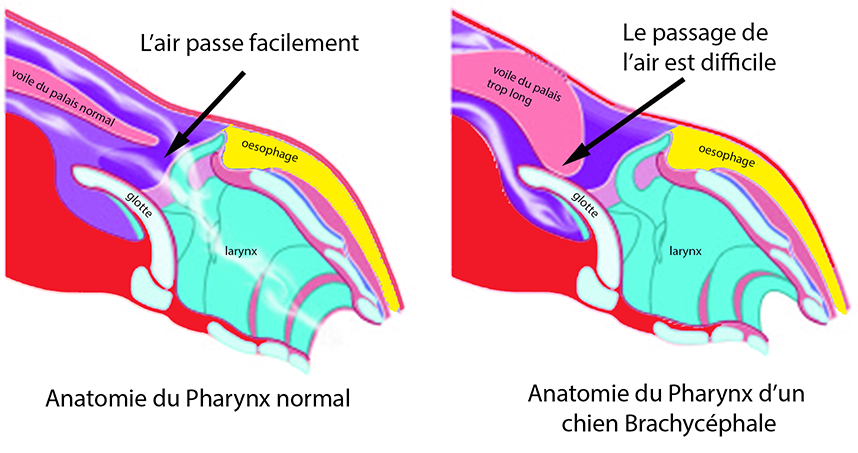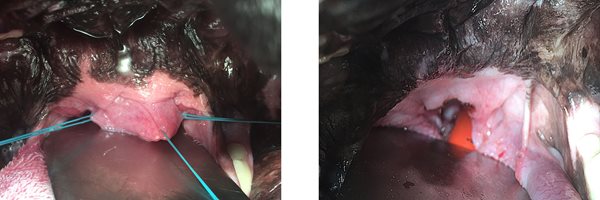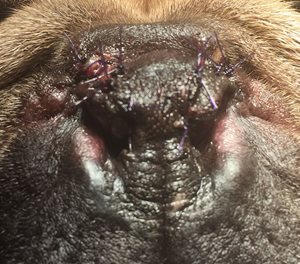Brachycephalic Syndrome: Palate and Nose Laser Surgery
- Le syndrome brachycéphale est un syndrome dont les composantes essentielles sont un palais trop long et des narines trop serrées (sténosées).
- It concerns as its name indicates the dogs with crushed noses (brachycephalic) such as the French Bulldog, the English Bulldog essentially, but also the Cavaliers King Charles, Shih-Tzu, Beijingois...
- In the mildest cases the syndrome manifests itself only by snoring, however most of the time it causes respiratory insufficiencies that can be catastrophic and lead to the death of the patient. It is exacerbated in summer with worsening symptoms and a clear intolerance to heat.
- Surgical treatment aims to eliminate respiratory insufficiency by reducing the soft palate and widening the nostrils.
- Laser surgery is currently the recommended technique of choice to treat this pathology.
Causes of the brachycephalic syndrome.
- Otherwise called obstructive airway syndrome, this syndrome essentially concerns dogs of so-called brachycephalic breeds which are characterized by a short skull, giving an aspect of the crushed nose. In these breeds, genetic selection has led to changes in the upper airways leading to an excessively long palate veil and narrowing of the nostrils (stenosis). There is also another digestive component of the brachycephalic syndrome with a tightening of the pylorus which can lead to regurgitations, this last anomaly however remains less frequent.
- The lengthening of the palatal veil and the stenosis of the nostrils impedes the normal passage of air to the trachea and lungs.
- The breeds concerned are essentially the French Bouledoque, the English Bulldog, the Cavalier King Charles, the Pug, the Shih-Tzu and the Pekingese.
Diagram of nostril stenosis in a dog brachycephalic
 Anatomical diagram of a long palate veil in a dog brachycephalic
Anatomical diagram of a long palate veil in a dog brachycephalic
Symptoms and consequences.
Snoring is the first symptom noticed in general, if it may seem harmless and not bother the dog, it should not be neglected and should lead to the question: is my dog breathing normally?
- Is it normal that he can't run for more than 10 minutes without getting out of breath?
- Is it normal that he can't stand the heat and has to stay locked up in the summer?
Respiratory failure is the real symptom of brachycephalic syndrome it manifests itself by:
- Severe respiratory dissections with shortness of breath and often cyanosis (mucous membranes and tongue may turn blue).
- A permanent intolerance to effort; the dog runs out of breath as soon as he gets excited.
- A clear worsening of symptoms in summer and intolerance to heat.
The consequences of respiratory failure can be catastrophic:
- Very rapid onset of right heart failure.
- Risk of developing pulmonary oedema.
- Significant risk of sudden dog death due to respiratory failure and/or heart failure.
- Respiratory failure with cyanosis occurs in the advanced stages, syncopations can occur due to lack of oxygen.
Diagnostic
- The diagnosis is essentially clinical with the observation of snoring, intolerance to effort and heat.
- Very short anaesthesia is often used to visualize the soft palate and plan the surgical treatment.
- A complete cardio-respiratory radiographic check-up is performed before any surgical decision is made. Cardiac echography and/or an electrocardiogram may also be necessary in cases of suspected heart failure.
- If pyloric stenosis with gastroesophageal reflux is suspected: digestive endoscopy may be indicated.
Surgical treatment
- In a broad way any brachycephalic snorer can be operated on, from a more pragmatic point of view the treatment is indicated for any dog presenting an intolerance to effort or heat. It is imperative for animals with respiratory insufficiency.
- It is not normal that a dog cannot walk for more than 10 minutes without being out of breath, without being forced to stop and a fortiori without being on the verge of asphyxiation.
- The treatment consists of an enlargement of the nostrils (Rhinoplasty) and a shortening of the soft palate (Palatoplasty).
The operations are performed under general anaesthesia and using a CO2
- The use of the CO2 laser is the technique currently universally recommended by veterinary surgeons.
- The laser allows faster and safer surgery for the patient by reducing bleeding and reducing postoperative oedema of the palate.
- Laser surgery dramatically reduces postoperative morbidity and ensures much simpler post-operative outcomes for the patient.
Appearance of the soft palate before and after palatoplasty by CO2 laser
Aspect of the nostrils after CO2 laser rhinoplasty

In the best case, the dogs return home the evening of the operation with medical treatment for a few days, sometimes post-operative monitoring at the clinic from 24h to 48h may be necessary.
Follow-up and post-operative care.
Instructions are clearly explained before the procedure and when the patient is discharged.
- The dog must be left in the calm for 10 days and the exercise proscribed for one month.
- Anti-inflammatories and analgesics are prescribed for a few days.
- The stitches on the nostrils disappear in about three weeks.
The improvement of the breathing capacities of the dog is normally immediate.
- The disappearance of respiratory failure
- Significantly improved effort tolerance.
- Much better tolerance to high temperatures.
Night snoring is greatly reduced, it may not disappear completely.
Complications are possible:
Although rare, death during anaesthesia may occur. The use of modern anaesthetic protocols and monitoring equipment (ECG, pulse oximetry, capnography) minimises the risk.
Infection is an uncommon complication.
Inflammation of the airways may persist for a few days and may require appropriate medical treatment in the weeks following the procedure.